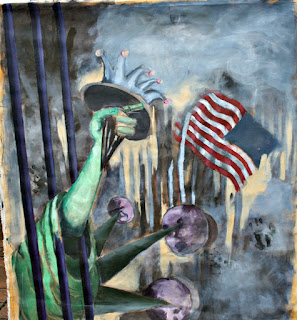We were directed to read about Jose Louis Borge whose talk on Metaphors as part of the This Craft of Verse series, was intriguing and it led me further down the road to an interview Ronald Christ conducted with Borges [www,theparisreview.org] where the author revealed that good metaphors are always the same - time as a road, life to dreaming and death to sleeping and that they follow a pattern. He was particularly fond of old Norse and Celtic metaphors where for instance, a battle is described as 'a web of men' and makes a link to George Eliot's metaphor in Middlemarch - where society is a web and one cannot disentangle a thread without touching all the component parts. He believed in the Stoic theory where everything in the universe is linked and he has been influenced in this by Schopenhauer [like De Chirico] and De Quincy. [I suspect there's something to be researched on this]
Sometimes, in the middle of an article, one idea/thought strikes me as particularly relevant to my own journey. Borges feels that with writers of fiction, it is not the idea that is so important but the enjoyment or emotion that one evokes in the reader that is paramount. He stresses that many famous and well known writers are competent, even brilliant in their craft but that they lack the ability or curiosity to enquire about the poetry and mystery of life. The same can be applied to painting, I think. Interestingly, he was an admirer of Yeats, Frost and Sandburg.
George Lakoff is another very interesting speaker on metaphor amongst other topics. His explanation of the term 'fiscal cliff' with reference to stock markets clarifies the importance of the use of imagery that can convey the message. The image of a cliff being a dangerous place with a downward direction is universal.
[Where Big ideas Fest 2012 Half moon Bay Ca Fora Tv George Lakoff] YouTube link to George Lakoff.
Jane Hirschfield's animation on Metaphors is deliciously simple yet manages to convey the complexity of the importance of a good metaphor which allows us to experience, feel and know the world we live in differently.
[https://www.youtube.com/watch?v=A0edKgL9EgM ] You Tube link to Jane Hirschfield.
That's it for now on metaphor and ending with the familiar phrase -
'There's no shortcut to anywhere worth going'.
Just as well I have my monthly transport pass so!


No comments:
Post a Comment